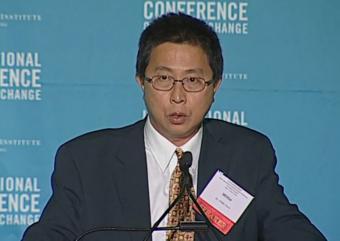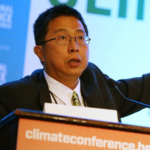Editor’s Note: Wei-Hock “Willie” Soon, Ph.D., is a geo-scientist at the Harvard-Smithsonian Center for Astrophysics. Soon has written papers in a number of peer-reviewed journals examining the relationship between solar phenomena and global climate. He recently coauthored a piece in Science Bulletin demonstrating a simple climate model displayed superior performance reflecting actual temperature trends when compared to the complex models used by the Intergovernmental Panel on Climate Change. The interview was conducted after Soon was honored at the Ninth International Conference on Climate Change (ICCC-9) in July 2014.
Burnett: Please tell our readers a little about your research background and how you became a climate skeptic.
Soon: My scientific adventure and passion started long ago. In 1991, I came to Cambridge, Massachusetts to begin my postdoctoral research studying magnetic activity and radiation outputs from our Sun and from about 100 Sun-like stars. We quickly found our Sun’s light output can change, resulting in a relatively large amplitude affecting Earth’s climate on timescales of 40 to 200 years.
This result challenges the theoretical claims for the dominant climatic role of human additions to atmospheric carbon dioxide, and I quickly learned that not accepting the politically supported climate agenda is unhealthy for a young scientist. The reason for persistent skepticism concerning human greenhouse gas emissions being the control knob for Earth’s climate system is simply because there no evidence for it. This is why the unscientific idea must be abandoned. It is really as simple as that.
Burnett: In a recent presentation, you explored the differences between climate alarmists’ claims and the actual records of sea-level rise and ground lift and subsidence in Alabama and Florida. What did you find?
Soon: In my talk to a group of engineering and business students at the University of Alabama-Tuscaloosa on January 26 of this year, I showed sea-level change around the coast of Florida and Alabama measured on the order of 0.8 to 2.8 mm/year, amounting to only 3–11 inches in a hundred years. But I quickly explained, from an accurate determination of vertical land movements through the use of modern GPS measurements, one finds the coastal regions around these areas have been consistently sinking at roughly the same rate. This immediately allows one to say most of the sea-level changes around these areas are not primarily related to changes in the sea level but instead are more related to the subsidence of the coastal land.
Burnett: What have you found to be the most disturbing aspect of the way the climate change debate, climate research, and climate policy have developed?
Soon: It is most sad and disappointing that in climate science, facts and evidence are never the primary focus of discussion or debate. Instead, ugly ad hominem attacks are quickly hurled upon any one who challenges the dogma of a human role in dangerous global warming. I have been a direct recipient of such outrageous attacks. People have even attempted to destroy my scientific research and career by requesting people sign on a petition to get me fired from my current workplace, so I know the current state of discussion is in very bad shape because of the outsized influence of anti-science activists and institutions.
Burnett: Are climate skeptics’ views tainted by the corrupting influence of money from corporate interests?
Soon: This is a very serious and old question. During my talk to the students at the University of Alabama, I posed the question of whether it is unethical for professor Stanley Prusiner, the discoverer of prions and the sole Nobel Prize winner for physiology in 1997, to accept the crucial funding he received from R.J. Reynolds Tobacco Company to carry on his research on prions. Prusiner openly said this critical funding advanced his award-winning and lifesaving research by at least 79 years by allowing him to secure the correct statistical sampling for identifying prions.
The bottom line for me is clear: Types of funding should never be any serious concern or barrier for a scientist as long as one can morally and ethically stay clear of any non-science influences. Prusiner’s example makes one wonder about the potential biases introduced when science funding is centralized and doled out by the government. Capture by a narrow-minded group of scientists is easily imaginable, isn’t it?
Burnett: You recently coauthored an article on climate models in the journal Science Bulletin, which has received a good deal of attention. What is the critical finding of this paper?
Soon: I would urge all readers to read the Science Bulletin paper. This paper reveals the current U.N. Intergovernmental Panel on Climate Change, also called IPCC, Fifth Assessment Report has greatly exaggerated the sensitivity of climate to atmospheric carbon dioxide, by at least 200–300 percent.
We based our result on a very careful consideration of the available measurements of global temperature data by satellites and atmospheric carbon dioxide, as well as the creation of a simple climate model.
Naturally, this paper has made many people in the church of climate alarmism very unhappy. They have insisted we are wrong, without even studying our paper. Unfortunately for those who rejected our paper in an uninformed way, we have clearly shown current complex climate models used by the IPCC consistently fail when compared to observations and have consistently exaggerated the role of atmospheric carbon-dioxide on climate.
INTERNET INFO
Christopher Monckton, et.al., “Why Models Run Hot: Results from and Irreducibly Simple Climate Model,” Science Bulletin, January 2015. http://heartland.org/policy-documents/why-models-run-hot-results-and-irreducibly-simple-climate-model






